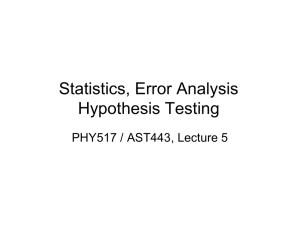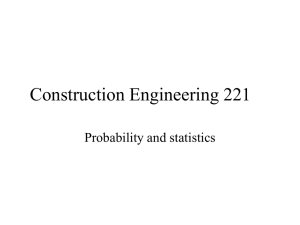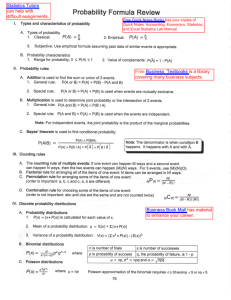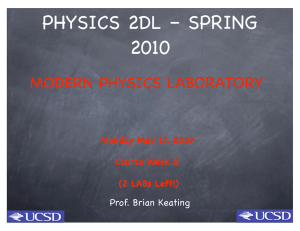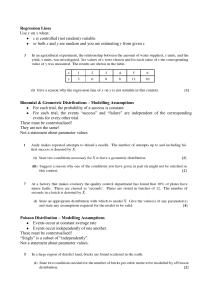PHYSICS 2DL – SPRING 2010 MODERN PHYSICS LABORATORY Prof. Brian Keating
advertisement
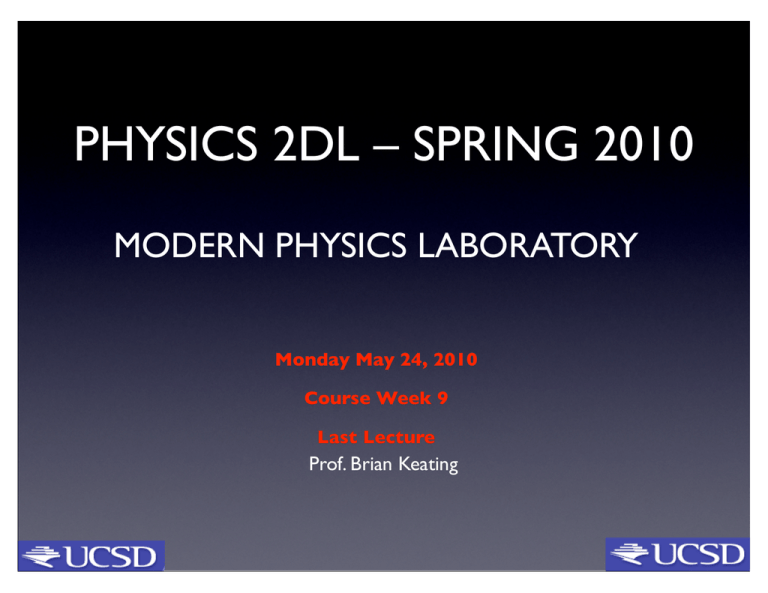
PHYSICS 2DL – SPRING 2010 MODERN PHYSICS LABORATORY Monday May 24, 2010 Course Week 9 Last Lecture Prof. Brian Keating 2DL Review Final Exam Closed Book, But You Can Bring: 1. Calculator (Scientific) 2. one 8.5” x 11” sheet of notes, HANDWRITTEN, front and back Topics • Averages • Variance • Distributions • Gaussian • Least squares • t-test • Chi-Sq • Binomial • Poisson + Other Topics & Statistics of the Six 2DL expts χ2 TEST for FIT Gauss distribution: χ~2 distribution: Prob( tσ Prob outside tσ from data ) A student measures the force on a length of wire (g) on a current carrying wire in a magnetic field versus the current I through the wire F/g (Force/Unit Length) The tabulated data and uncertainties are shown below. I, (A) F/g (N/m) 0 0±1 1 12±1 2 21±1 3 30±1 4 39±1 5 50±1 a) The student wants to perform a least-square fit to the theory relation Write an expression for and DERIVE an expression for B in terms of the data values. b) What is the best-fit value of B for the data? c) What is the reduced value of d) Using the table from Appendix D assess the agreement between the fit and the theory. a. b. c. Table D d. Here’s our “final” example of the general technique when fitting for only a slope…. See Taylor Problem 8.18 Don’t Use Linear fit with A=0! Ch 10 Binomial Distribution Why Binomial? Because only 2 outcomes of a given test. Either X happened or it didn t, where X can be a complicated statement like: When throwing 3 coins sequentially, what s the probability that the sequence observed was HHT Ch 10 Binomial Distribution Binomial coefficient . 20 trials, with Symmetric only if p = q. Ch 10 Binomial Distribution The binomial distribution describes the behavior of a count variable X if the following conditions apply: 1: The number of observations n is fixed. 2: Each observation is independent. 3: Each observation represents one of two outcomes ("success" or "failure"). 4: The probability of "success" p is the same for each outcome. Binomial Distributions in Practice • You should really know when to use the Gaussian hypothesis. When the number of attempts/trials is > 15, you are safe. Then : •Then use the one or two sided t-probability distributions to get the probability. •This is nice also because calculating the factorial is very computationally demanding when N > 50. Binomial Example • What’s the probability of getting 27 Heads out of 34 tosses of a coin? 27 () MICROSOFT EXCEL: =BINOMDIST(23,36,0.5,FALSE) MICROSOFT EXCEL: =NORMDIST(x,mean,standdev,FALSE) http://www.stat.sc.edu/~west/javahtml/CLT.html Ch 11 Poisson Distribution Given a Poisson process, the probability of obtaining exactly n successes in N trials is given by the limit of a binomial distribution Now, instead of looking at getting n out of N if we define the number of of successes, we can set: n = = = = = Poisson – again should know when to use Gaussian • Because Poisson is hard to calculate (with factorial) and because it’s easier to find probability tabulated for Gaussian distribution. • Approximation to use: • Then use t-values to answer likelihood questions. • Caveat- N must be large! Better if large and symmetric. e/m for the electron Electron-Positron Pair Mass Spectrometer GOOD LUCK • Email me or TA’s with any questions • HAVE A GREAT SUMMER 26
